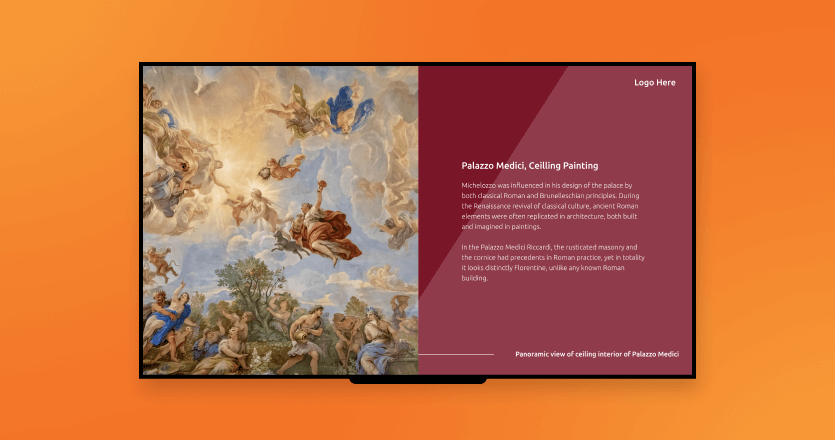Museums are considered to be a window to the past, present, and future that offer you a glimpse into history, culture, and art. You can think of them as the guardians of our heritage, and they play an essential role in educating and inspiring us. However, in the 21st century, traditional methods of communication have completely changed, and museums must adapt to meet their visitors’ expectations and not feel outdated.
What are museum displays called?
In museums, displays are often referred to as signage. These may include educational panels, navigational signs, exhibit labels, and interactive kiosks. Signage is a crucial source of communication, leading visitors through the museum’s many areas, providing context for exhibits, and increasing engagement with the collections.
Why is signage important in a museum?
Without a doubt, signage is of the utmost importance in a museum for many different kinds of reasons. Firstly, it improves wayfinding, allowing visitors to navigate the museum’s layout and discover specific exhibits or facilities easily. It is unquestionably proven that clear and straightforward signage helps avoid misunderstandings while improving the overall tourist experience.
Secondly, museum signage gives useful information about artifacts, artworks, and exhibitions by providing context, interpretation, and educational material to help visitors have a better understanding of their surroundings. In addition, signage improves the overall museum’s aesthetic appeal by complimenting its designs, increasing its atmosphere, and keeping it up to date.
Benefits of digital signage in a museum
Enhanced engagement
Digital signage in museums offers dynamic content such as videos, animations, and interactive features that will draw visitors’ attention effectively and will push them to interact with displays in greater depth. Comparatively to static signage, digital displays can provide information in a visually appealing and engaging way that will boost participation and create a lasting museum experience for everyone.
Real-time updates
Digital signage allows museums to simply update content in real time to reflect changes in exhibitions, events, or visitor demographics. This adaptability ensures that signage is relevant and helpful, giving visitors updated information and improving their entire visit.
Customization possibilities
Digital signage solutions provide numerous customization possibilities that allow museums to personalize their information to meet individual needs and goals. Whether displaying high-resolution images of artworks, streaming educational videos, or promoting upcoming events, digital signage allows museums to deliver captivating and relevant messages that will fully resonate with their target audience.
Data & analytics
Analytic elements are frequently included in digital signage solutions, giving museums important insights into visitor behavior, preferences, and levels of engagement. By studying this data, museums may optimize signage placement, content strategy, and visitor flow, thus improving the overall visitor experience and satisfaction.
How to use digital signage in museums

Exhibit signage
Digital screens can replace traditional printed labels to provide detailed information, multimedia content, and interactive experiences about historical items or artworks. Thus, museums that use digital signage for exhibit signage can provide visitors with a more educational experience, enhancing the understanding and enjoyment of the exhibits.
Wayfinding
Digital signage can be utilized to navigate visitors through the museum’s layout using interactive maps, directional arrows, and location-specific information. Digital navigational signage improves the whole museum experience by allowing visitors to navigate more easily and intuitively.
Visitor engagement
Interactive quizzes, games, and multimedia presentations can help visitors become more engaged. By encouraging participation and learning, digital signage lifts the museum experience from passive observation to interactive discovery, building a more powerful connection between visitors and the works of art.
Promotional displays
Use digital signs to promote forthcoming events, activities, and special displays. By displaying engaging images and useful text, digital promotional displays capture visitors’ attention and inspire them to explore further offerings, hence increasing attendance and participation.
Educational content
Digital signage can be used to display educational content such as movies, documentaries, and virtual tours. By providing information in a visually appealing and accessible style, digital signage improves the educational value of the museum experience, making learning more pleasurable and accessible to visitors of all ages.
Yodeck digital signage solution
When it comes to implementing digital signage in museums, Yodeck offers an extensive solution that can adjust to the specific requirements of cultural institutions. Yodeck’s user-friendly interface and cloud-based platform allow you to easily create, manage, and deploy digital signage content across multiple screens and locations.
Yodeck offers a variety of customizable templates and apps, allowing museums to deliver dynamic and engaging content that captures visitors’ attention and enriches their museum experience. Yodeck empowers museums to provide effective messaging that resonates with their audience, whether by displaying high-quality images of artworks, streaming educational videos, or promoting upcoming events.

The evidence presented in this article suggests that museums, in order to enhance the overall experience for their audience, must evolve. This evolution can come through the use of digital signage. Museums can take advantage of the dynamic possibilities of digital signage to engage, educate, and inspire visitors in new and unique ways, ensuring that their cultural treasures are accessible and relevant to people of all ages. Therefore, museums can start their digital transformation with solutions like Yodeck, which can make these changes easily and effectively!
